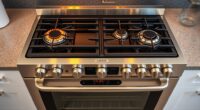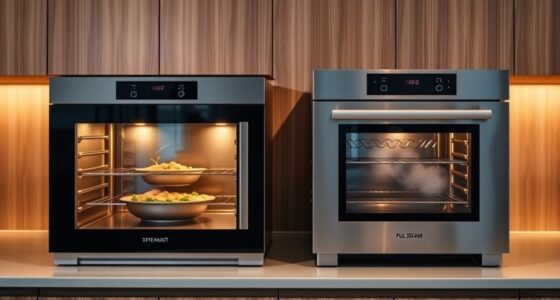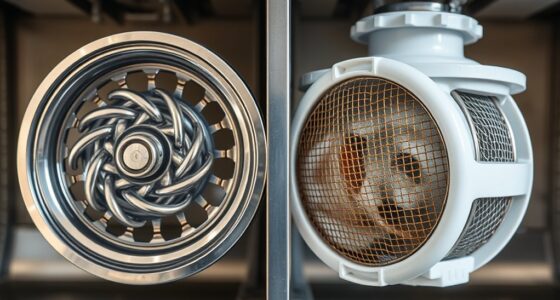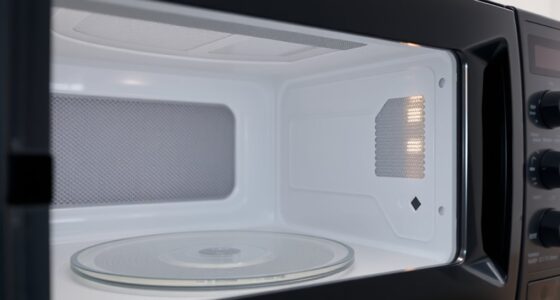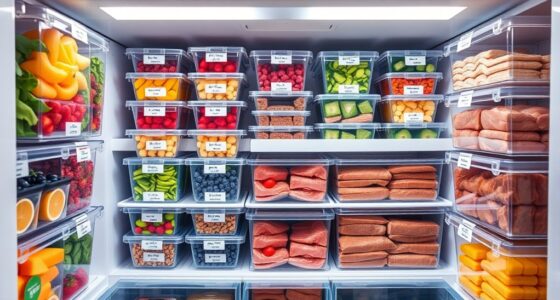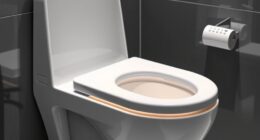Air fryers circulate hot air rapidly with a focused fan close to the food, creating a crispy exterior quickly and efficiently. Convection ovens use larger heating elements and a fan that circulates air more evenly but may develop hot spots, leading to longer cooking times. This difference impacts texture and speed—air fryers often produce crispier results faster, while convection ovens balance even cooking with a larger capacity. Explore further to understand how these differences can work best for your needs.
Key Takeaways
- Air fryers use focused, high-velocity hot air circulation close to food for rapid, even crispiness.
- Convection ovens have larger fans and multiple heating elements, providing broader, more gradual heat distribution.
- Air fryers often produce more consistent crispy results due to concentrated airflow and efficient heat transfer.
- Convection ovens may develop hotspots near heating elements, leading to less uniform cooking.
- Faster heat transfer in air fryers shortens cooking times, while convection ovens excel at evenly cooking larger quantities.
How Air Fryers Circulate Hot Air for Cooking
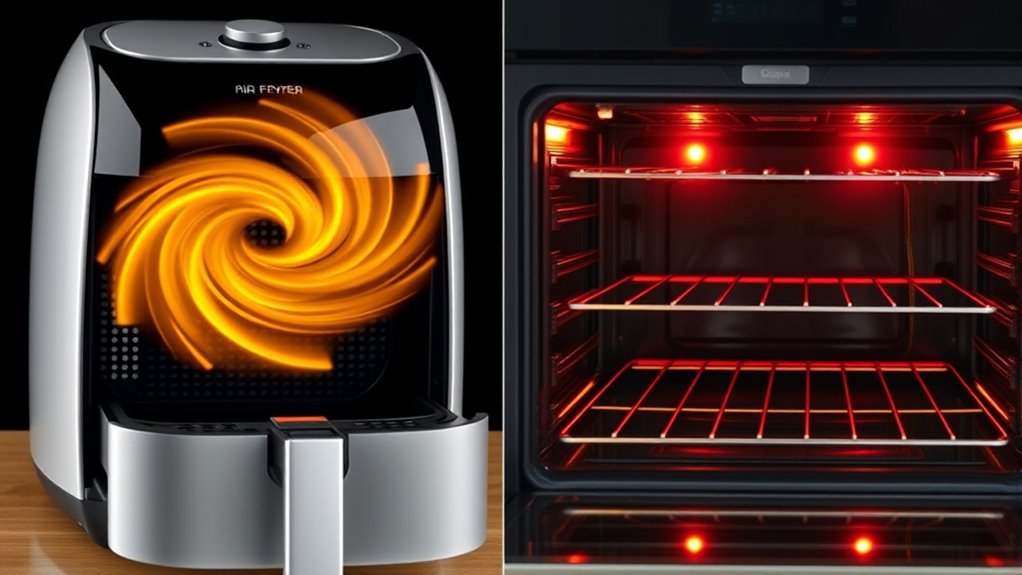
Air fryers cook food by rapidly circulating hot air around it, which creates a crispy exterior without needing much oil. This process is driven by a powerful fan located near the heating element, which evenly distributes hot air in all directions. As the air moves quickly, it surrounds your food, cooking it evenly on all sides. The high-speed circulation ensures that heat reaches the surface faster than traditional methods, resulting in a crispy texture similar to deep frying. Because the air is constantly moving, there’s less chance of hot spots or uneven cooking. This efficient heat transfer allows you to prepare healthier meals with less oil while still achieving that desirable crunch. The rapid air movement is key to the unique cooking style of air fryers. Understanding heat transfer science helps explain how this efficient circulation creates such consistent results, especially when considering airflow dynamics within the cooking chamber. Additionally, fan and heating element design plays a crucial role in maintaining optimal airflow and temperature consistency throughout the cooking process. Moreover, filtering mechanisms help maintain air quality and prevent the buildup of odors during operation. Proper airflow control also contributes to even cooking and energy efficiency, making air fryers a popular choice for quick, healthy meals.
The Design and Heating Elements of Convection Ovens
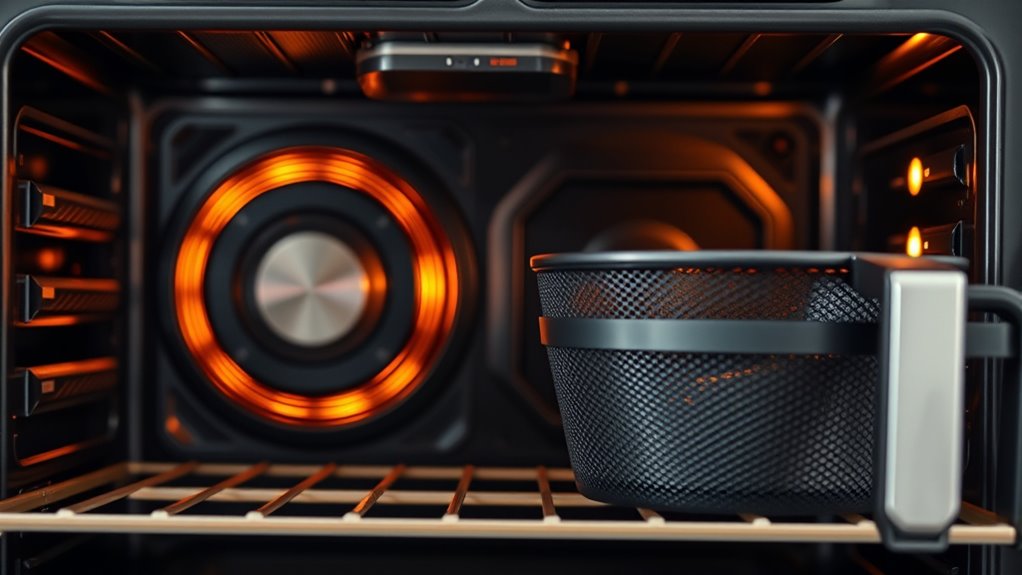
Convection ovens are designed with a built-in fan and a heating element that work together to circulate hot air evenly throughout the cooking chamber. The heating element, usually located above or around the fan, heats the air quickly and efficiently. The fan then distributes this hot air uniformly, ensuring consistent cooking results. Many convection ovens feature multiple heating elements, such as top and bottom coils, to optimize heat distribution. The combination of these components allows for faster cooking times and even browning. Additionally, some models include convection fans with variable speeds to fine-tune airflow based on cooking needs. This integrated design makes convection ovens versatile and reliable for achieving evenly cooked meals. Controlling airflow with adjustable fan speeds enhances cooking precision and results. Proper heat distribution is essential for consistent cooking, and the design of these appliances aims to maximize that aspect. Incorporating advanced engineering principles ensures optimal performance and efficiency in heat transfer. Furthermore, heat transfer efficiency depends heavily on the quality of the components and their arrangement within the oven.
Comparing Heat Distribution Patterns in Both Appliances
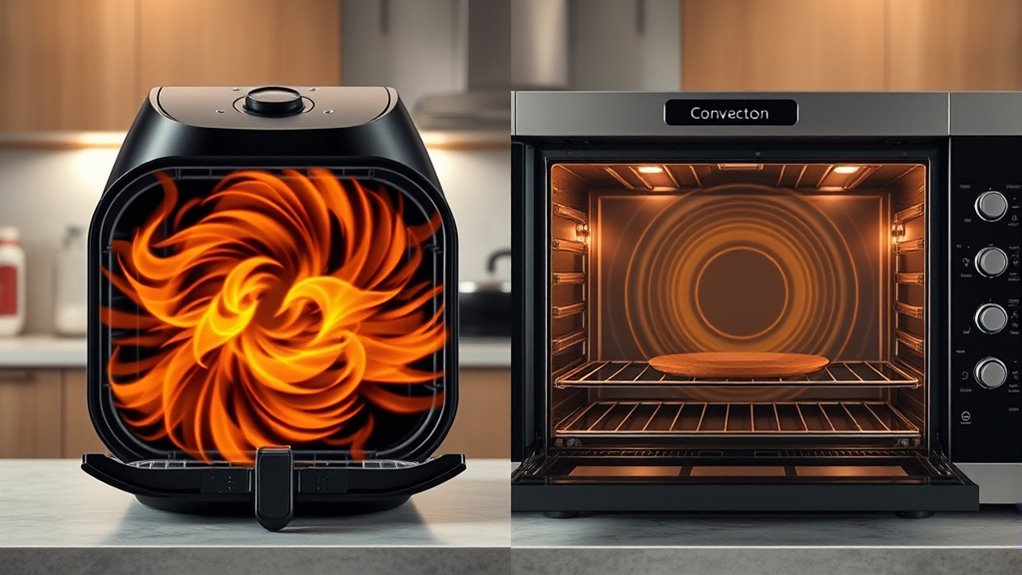
While both appliances use fans to circulate heated air, their heat distribution patterns differ considerably. In a convection oven, heat tends to be more even but can vary depending on the placement of heating elements and oven rack positioning. The fan circulates air around the entire chamber, but hotspots may develop near the heating elements, causing uneven cooking. Conversely, an air fryer’s fan is typically positioned closer to the food, creating a more focused, high-velocity airflow. This results in rapid and uniform heat coverage, especially around the food’s surface. As a result, air fryers often produce more consistent results for crispy textures. Additionally, heat distribution technology in air fryers is designed to maximize efficiency and crispiness. The airflow dynamics in air fryers are optimized for small, compact spaces, further enhancing their cooking performance. Understanding these differences helps you anticipate how each appliance will handle different dishes, influencing cooking times and overall outcomes. Moreover, the thermal circulation patterns significantly impact cooking precision, making each appliance suitable for specific culinary tasks. Proper understanding of heat flow can help optimize cooking results by leveraging each appliance’s unique strengths, especially considering the biological factors that influence how heat interacts with various foods.
Impact of Heat Distribution on Food Texture and Cooking Time
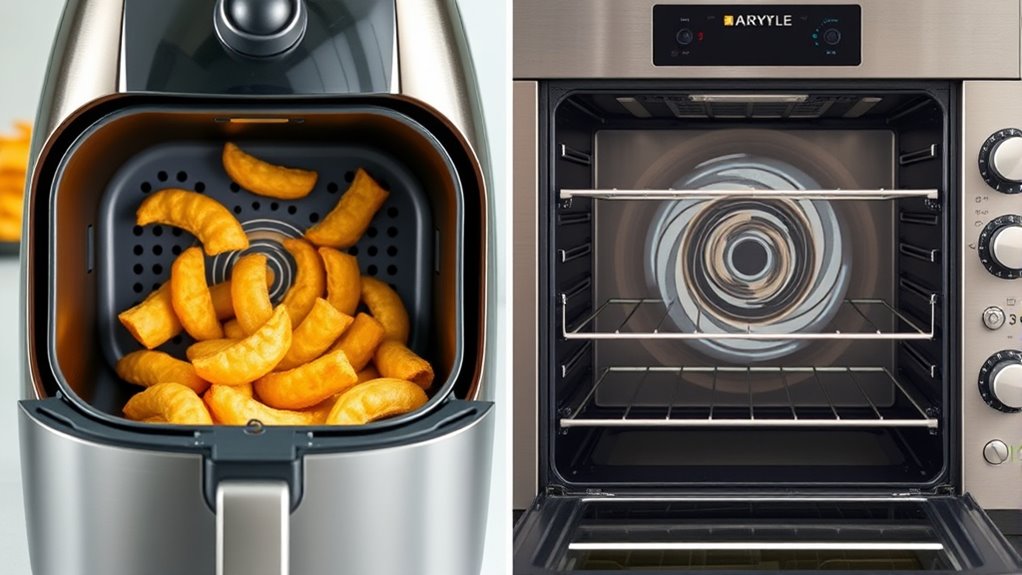
The way heat is distributed inside each appliance directly influences how your food turns out regarding texture and cooking time. When heat circulates evenly, your food cooks faster, with a crisp exterior and tender interior. Heat distribution plays a crucial role in achieving optimal results in both appliances. Uneven heat, on the other hand, can lead to undercooked sections or soggy textures. In an air fryer, rapid and uniform heat flow creates crispy coatings and reduces cooking time for small batches. Convection ovens may take longer but can produce more evenly cooked dishes, especially larger quantities. Proper air circulation ensures consistent cooking and helps prevent hot spots that can compromise food quality. Additionally, understanding the industry trends can help you select the best appliance for your specific cooking needs.
Choosing the Right Appliance Based on Heat Transfer Efficiency
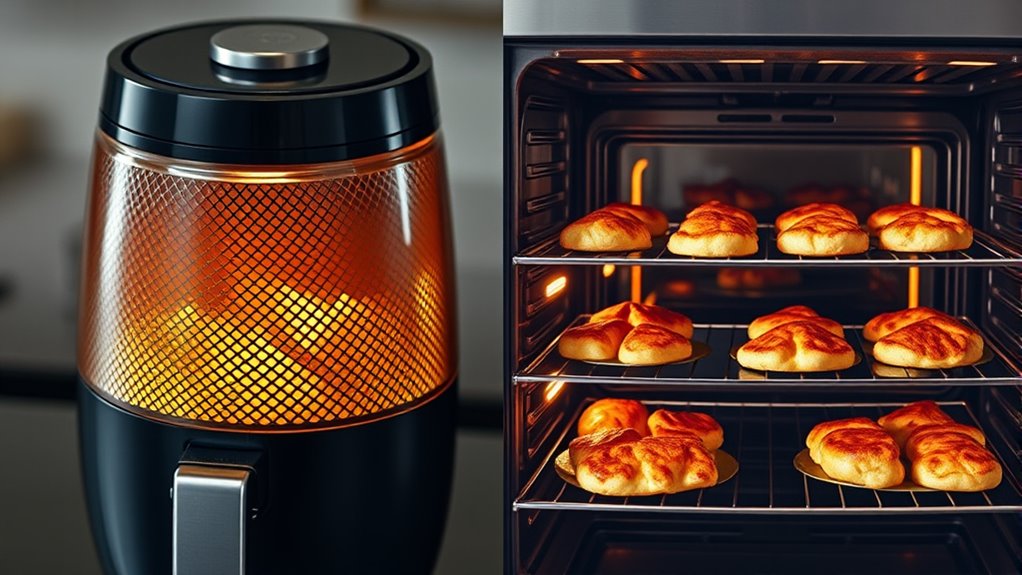
Choosing the right appliance depends largely on how effectively it transfers heat to your food. Air fryers excel at rapid heat transfer through small, powerful fans that circulate hot air quickly, creating a crispy exterior in less time. Convection ovens transfer heat more gradually, relying on larger heating elements and slower air circulation, which can lead to more even cooking but longer times. If you want quick results with crispy textures, an air fryer is your best choice. For larger batches or more gentle, even heating, a convection oven works better. Consider your typical cooking needs—speed versus capacity—and how important precise heat distribution is for your dishes. Matching your goals with each appliance’s heat transfer capabilities ensures better results and more efficient cooking.
Frequently Asked Questions
How Does Food Placement Affect Heat Distribution in Air Fryers and Convection Ovens?
You should pay attention to how you place food in your air fryer or convection oven because it directly affects heat distribution. If you overcrowd the basket or tray, air can’t circulate properly, leading to uneven cooking. For best results, spread food in a single layer and avoid overlapping. This allows hot air to evenly reach every piece, ensuring consistent crispiness and thorough cooking.
What Role Does Fan Speed Play in Heat Circulation Efficiency?
You should know that fan speed directly impacts heat circulation efficiency. When you increase the fan speed, it pushes hot air more forcefully around your food, ensuring even and faster cooking. Conversely, if the fan runs slower, heat movement slows down, potentially leading to uneven results. Adjusting the fan speed helps you control how evenly your food cooks, maximizing efficiency and preventing hotspots or cold spots.
Can Modifying Temperature Settings Improve Heat Distribution Uniformity?
You wonder if tweaking temperature settings can boost heat distribution. The answer is yes—adjusting temperatures can help achieve more even cooking, especially if your appliance has multiple heat zones. By setting the right temperature, you help the fan circulate hot air more uniformly, reducing cold spots. Keep in mind, gradual adjustments and testing different settings can fine-tune the heat flow, making your cooking more consistent and enjoyable.
How Do Different Rack or Tray Positions Impact Cooking Results?
You should pay attention to rack or tray positions because they directly affect your cooking results. Placing food in the center usually guarantees even heat exposure, leading to consistent doneness. If you move items closer to the heating element, expect faster browning or crisping. Avoid overcrowding, as it blocks airflow. Experiment with different positions to find the best spot for your specific dish, maximizing even cooking and desired texture.
Are There Specific Foods Better Suited to One Appliance’S Heat Pattern?
Certain foods cook better with specific appliances due to their heat patterns. If you’re preparing items like crispy fries or chicken wings, an air fryer’s rapid, intense heat creates a crispy exterior quickly. Conversely, baked goods like casseroles or bread benefit from a convection oven’s even, gentle heat for thorough cooking. You’ll get better results by choosing the appliance that matches the food’s ideal heat exposure and texture goals.
Conclusion
Now that you understand how air fryers and convection ovens dance with heat, you can pick your perfect partner. Think of the air fryer as a swift wind, crisping your food to perfection, while the convection oven is a steady tide, evenly bathing everything in warmth. Your choice hinges on how you want your culinary journey to unfold—quick and crispy or slow and even. Whichever you choose, you’re steering your kitchen’s heat symphony.

